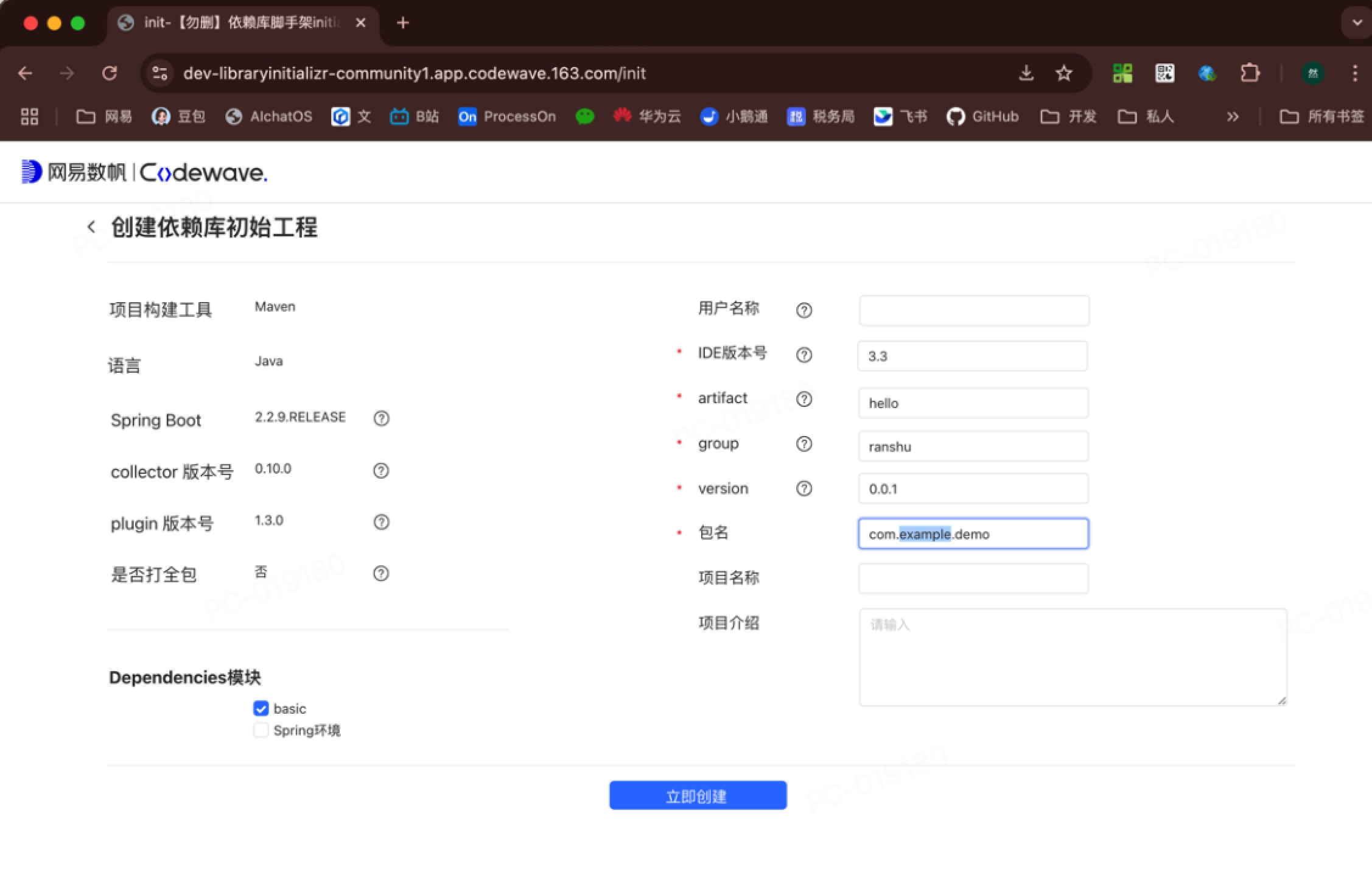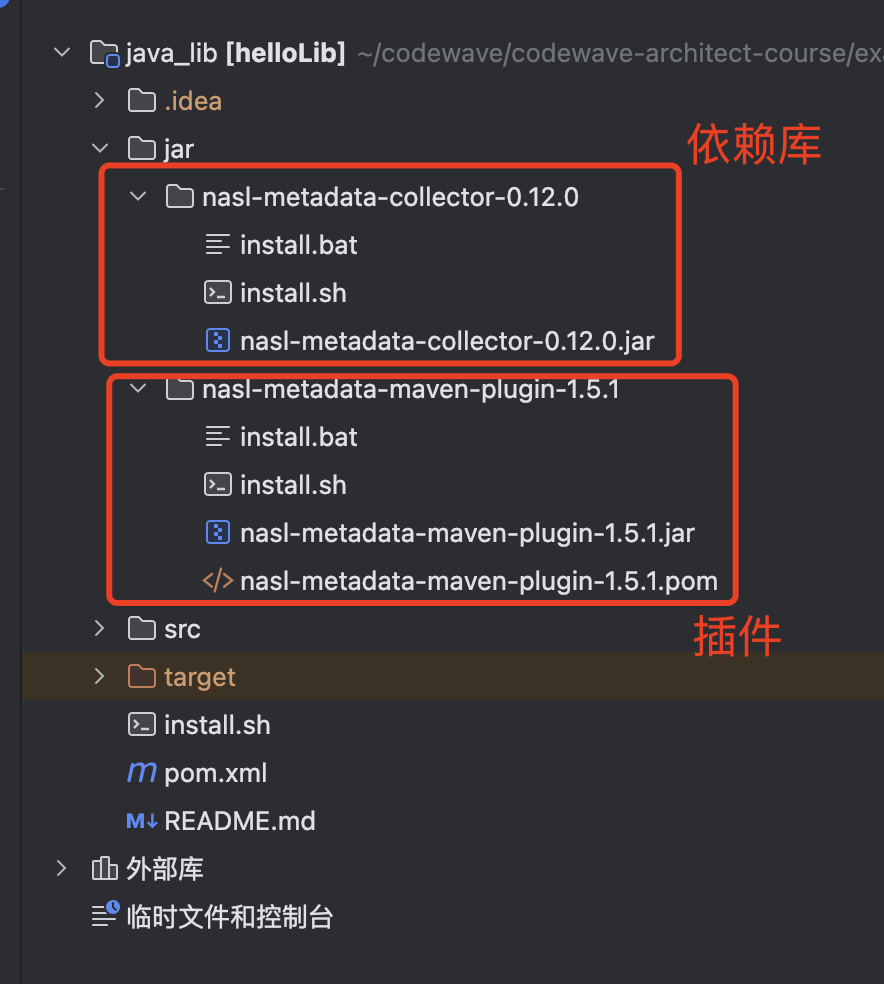Appearance
连接器开发
作者:全栈然叔
一、概念原理
CodeWave平台的连接器是一种用于连接第三方服务、系统或数据源的工具。通过CodeWave平台的连接器,开发者可以在轻松地访问其他系统中的数据和功能,从而实现不同系统之间的数据交换和应用集成。
连接器分类
内置的系统连接器
- 文件存储连接器
- Apollo配置中心连接器
自定义连接器
- 低码方式
- 第三方API接入
- 第三方回调(触发器)
- SSE协议支持(AI对话流式输出)
- 高码方式
- 第三方Java依赖库对接
- 订阅发布(例: MQ消息订阅)
- 低码方式
二、使用场景
实现Http协议通讯方式的连接器可以使用高码方式展开。但如果使用其他类型的通讯协议比如mqtt、socket或者是直接通过调用第三方依赖库实现。这种情况适合采用高码方式开发连接器。
案例1:连接器
Redis连接器
案例2:连接器(订阅发布模式)
RabbitMQ连接器
三、实操演练
开发环境准备
Codewave版本: 3.11
运行时环境:JDK: openjdk version "1.8.0_422"
构建工具: Maven: 3.9.9
开发工具: IDEA社区版 2024.2(仅当做编辑器使用,创建测试完全依赖于Maven)
版本控制: Git 2.39.3
源码位置:https://github.com/netease-lcap/codewave-architect-course/tree/main/example/connector
创建项目
扩展依赖的项目是一个基于Maven构建的Java项目。和一般Java项目的区别是需要添加相应的依赖和生成元数据的Maven插件。
创建项目推荐使用脚手架模式创建。
脚手架地址:https://libraryinitializr-community1.app.codewave.163.com/init

项目中可以选择Dependencies模块需要选择Spring环境: 支持创建Spring组件逻辑
如果一开始没有想好,为了扩展方便。推荐选择Spring环境。
安装依赖库与插件
在下载的项目中 /jar 文件夹中包含一个插件和一个依赖库。
需要运行各种文件夹中的 install.sh 文件安装至本地仓库。

也可以在根目录下安装一个install.sh脚本快速执行
sh
#!/bin/bash
# 检查jar文件夹是否存在
if [ -d "jar" ]; then
# 获取jar文件夹下的一层子文件夹列表
subfolders=$(find jar -mindepth 1 -maxdepth 1 -type d)
for folder in $subfolders; do
install_script="$folder/install.sh"
if [ -f "$install_script" ]; then
echo "Adding execute permission to $install_script..."
chmod +x $install_script
echo "Executing $install_script in $folder..."
(cd "$folder" &&./install.sh)
else
echo "install.sh not found in $folder"
fi
done
else
echo "The 'jar' folder does not exist."
fi安装后可以运行
bash
mvn clean package确保环境搭建无误。
基础知识(Connector)
定义连接器
自定义一个类,在类上添加@NaslConnector注解,指定connectorKind,使用字母、数字或下划线组成,且以字母开头,kafka、redis、app已被官方使用,作为连接器的唯一标识。
连接器实现是多例的,建议都使用非静态方法、非静态成员变量(使用静态方法和成员变量打包也不会报错)
java
package com.codewave.connector;
import com.netease.lowcode.core.annotation.NaslConnector;
import java.util.function.Function;
@NaslConnector(connectorKind = "myConnector")
public class MyConnector {
}定义创建逻辑(Creator)
自定义方法,添加@NaslConnector.Creator注解。
- 入参只支持Boolean、Integer、Long、Double、String、LocalDate、LocalTime、ZonedDateTime、BigDecimal、List、Map。
- 不支持自定义抛出异常(目前使用脚手架没有把抛出的异常信息打包到nasl),抛出异常使用RuntimeException。
- 返回对象必须为当前类的实例对象,不建议使用单例模式,因为可以配置多个同一类型连接器。
- 该方法需要能在main方法中进行调用,不依靠spring的自动注入。
java
package com.codewave.connector;
import com.netease.lowcode.core.annotation.NaslConnector;
import java.util.function.Function;
@NaslConnector(connectorKind = "myConnector")
public class MyConnector {
private String appKey;
// Add ....
@NaslConnector.Creator
public MyConnector initBean(String appKey) {
MyConnector myConnector = new MyConnector();
myConnector.appKey = appKey;
return myConnector;
}
}定义连通性测试(Tester)
自定义方法,添加@NaslConnector.Tester注解。
- 入参的类型、顺序必须和@NaslConnector.Creator定义的方法一样,不一致会在连通性测试的时候报反射异常错误。
- 不支持自定义抛出异常(目前使用脚手架没有把抛出的异常信息打包到nasl),抛出异常使用RuntimeException。
- 返回对象必须为Boolean。
java
package com.codewave.connector;
import com.netease.lowcode.core.annotation.NaslConnector;
import java.util.function.Function;
@NaslConnector(connectorKind = "myConnector")
public class MyConnector {
private String appKey;
// Add ....
@NaslConnector.Tester
public Boolean test(String appKey) {
if (null != appKey && appKey.equals("myAppKey")) {
return true;
}
return false;
}
}定义逻辑(Logic)
自定义一个类,在类上添加@NaslConnector注解,指定connectorKind,使用字母、数字或下划线组成,且以字母开头,kafka、redis、app已被官方使用,作为连接器的唯一标识。
连接器实现是多例的,建议都使用非静态方法、非静态成员变量(使用静态方法和成员变量打包也不会报错)。
java
package com.codewave.connector;
import com.netease.lowcode.core.annotation.NaslConnector;
import java.util.function.Function;
@NaslConnector(connectorKind = "myConnector")
public class MyConnector {
// Add ....
@NaslConnector.Logic
public Integer add(Integer a, Integer b) {
return a + b;
}
}本地自测
java
package com.codewave.connector;
import com.netease.lowcode.core.annotation.NaslConnector;
import java.util.function.Function;
@NaslConnector(connectorKind = "myConnector")
public class MyConnector {
// Add ....
public static void main(String[] args) {
MyConnector myConnector = new MyConnector().initBean("appKey");
myConnector.test("appKey");
Integer add = myConnector.add(1, 1);
}连接器发布
bash
mvn clean package订阅发布模式(Trigger触发器)
java
package com.codewave.connector;
import com.netease.lowcode.core.annotation.NaslConnector;
import java.util.function.Function;
@NaslConnector(connectorKind = "myConnector")
public class MyConnector {
public EventBus eventBus;
@NaslConnector.Creator
public MyConnector initBean(String appKey) {
MyConnector myConnector = new MyConnector();
myConnector.appKey = appKey;
// 初始化事件总线
myConnector.eventBus = new EventBus();
return myConnector;
}
@NaslConnector.Trigger
public void subscribe(String topic, Function<String, String> handle) {
eventBus.subscribe(topic, handle);
}
public static class EventBus {
private final Map<String, Queue<Function<String, String>>> subscribers = new ConcurrentHashMap<>();
// 订阅事件,接收一个Function作为处理器
public void subscribe(String eventType, Function<String, String> handler) {
subscribers.computeIfAbsent(eventType, k -> new ConcurrentLinkedQueue<>())
.add(handler);
}
// 发布事件
public void publish(String eventType, String message) {
Queue<Function<String, String>> handlers = subscribers.get(eventType);
if (handlers != null) {
// 创建副本避免并发修改问题
List<Function<String, String>> copy = new ArrayList<>(handlers);
copy.forEach(handler -> {
try {
String result = handler.apply(message);
System.out.printf("事件 [%s] 处理结果: %s%n", eventType, result);
} catch (Exception e) {
System.err.printf("处理事件 [%s] 时出错: %s%n", eventType, e.getMessage());
}
});
}
}
}
public static void main(String[] args) {
MyConnector myConnector = new MyConnector().initBean("appKey");
myConnector.test("appKey");
Integer add = myConnector.add(1, 1);
System.out.println("add result :" + add);
// 订阅事件并处理消息
myConnector.subscribe("news", message -> {
System.out.println("收到新闻: " + message);
return "消息已记录";
});
// 发布事件
myConnector.eventBus.publish("news", "Java 21发布了");
}
}开发案例
案例1:Redis连接器
- 实现setValue、getValue逻辑
- 利用Trigger实现消息订阅发布功能
java
package com.codewave.connector;
import com.netease.lowcode.core.annotation.NaslConnector;
import io.lettuce.core.RedisClient;
import io.lettuce.core.RedisURI;
import io.lettuce.core.api.StatefulRedisConnection;
import org.slf4j.Logger;
import org.slf4j.LoggerFactory;
import org.springframework.beans.factory.DisposableBean;
import org.springframework.data.redis.connection.MessageListener;
import org.springframework.data.redis.connection.RedisConnectionFactory;
import org.springframework.data.redis.connection.RedisStandaloneConfiguration;
import org.springframework.data.redis.connection.lettuce.LettuceConnectionFactory;
import org.springframework.data.redis.core.RedisTemplate;
import org.springframework.data.redis.serializer.StringRedisSerializer;
import java.nio.charset.StandardCharsets;
import java.time.Duration;
import java.time.temporal.ChronoUnit;
import java.util.function.Function;
/**
* Redis 连接器,可连接第三方Redis服务并执行操作
*/
@NaslConnector(connectorKind = "redis_connector")
public class RedisConnector {
private static final Logger logger = LoggerFactory.getLogger(RedisConnector.class);
// RedisTemplate
private RedisTemplate<String, String> redisTemplate;
/**
* 初始化 Redis 连接
*
* @param host redis地址
* @param port redis端口
* @param password redis密码
* @param database redis数据库
* @return
*/
@NaslConnector.Creator
public RedisConnector initRedisTemplate(String host, Integer port, String password, Integer database) {
// 初始化 RedisConnector
RedisConnector redisTool = new RedisConnector();
// 初始化 RedisStandaloneConfiguration
RedisStandaloneConfiguration redisStandaloneConfiguration = new RedisStandaloneConfiguration();
redisStandaloneConfiguration.setPort(port);
redisStandaloneConfiguration.setDatabase(database);
redisStandaloneConfiguration.setHostName(host);
redisStandaloneConfiguration.setPassword(password);
// 初始化 LettuceConnectionFactory 作用:创建 Redis 连接
LettuceConnectionFactory redisConnectionFactory = new LettuceConnectionFactory(redisStandaloneConfiguration);
redisConnectionFactory.afterPropertiesSet();
// 初始化 RedisTemplate 作用:设置序列化器
RedisTemplate<String, String> _redisTemplate = new RedisTemplate<>();
_redisTemplate.setConnectionFactory(redisConnectionFactory);
_redisTemplate.setKeySerializer(new StringRedisSerializer());
_redisTemplate.setValueSerializer(new StringRedisSerializer());
_redisTemplate.setHashKeySerializer(new StringRedisSerializer());
_redisTemplate.setHashValueSerializer(new StringRedisSerializer());
_redisTemplate.afterPropertiesSet();
redisTemplate = _redisTemplate;
redisTool.redisTemplate = _redisTemplate;
return redisTool;
}
/**
* 测试链接是否可用,如果可用,则返回 true,否则返回 false
*
* @param host redis地址
* @param port redis端口
* @param password redis密码
* @param database redis数据库
* @return
*/
@NaslConnector.Tester
public Boolean testConnection(String host, Integer port, String password, Integer database) {
// 初始化 RedisURI
RedisURI redisURI = RedisURI.Builder.redis(host, port).withPassword(password).withDatabase(database).withTimeout(Duration.of(3, ChronoUnit.SECONDS)).build();
// 初始化 RedisClient
RedisClient client = RedisClient.create(redisURI);
try (StatefulRedisConnection<String, String> connect = client.connect()) {
// 测试链接是否可用
String pong = connect.sync().ping();
logger.info("测试链接是否可用:{}", pong);
return "PONG".equals(pong);
} catch (Exception e) {
return false;
} finally {
// 连通性测试后关闭连接
client.shutdown();
}
}
/**
* 关闭redis连接
*/
public void close() throws Exception {
if (redisTemplate != null) {
// 获取连接工厂
RedisConnectionFactory connectionFactory = redisTemplate.getConnectionFactory();
if (connectionFactory != null) {
// 关闭连接
connectionFactory.getConnection().close();
if (connectionFactory instanceof DisposableBean) {
try {
// 关闭连接工厂, 连接工厂也需要关闭,要不然连接池不会回收
((DisposableBean) connectionFactory).destroy();
} catch (Exception closeException) {
throw closeException;
}
}
}
}
}
/**
* 指定 key 的值为指定字符串
*
* @param key
* @param value
* @return
*/
@NaslConnector.Logic
public String setValue(final String key, final String value) {
redisTemplate.opsForValue().set(key, value);
return value;
}
/**
* 删除指定的key
*
* @param key
*/
@NaslConnector.Logic
public Boolean deleteKey(final String key) {
redisTemplate.delete(key);
return true;
}
/**
* 获取指定key的值
*
* @param key
* @return
*/
@NaslConnector.Logic
public String getValue(final String key) {
return redisTemplate.opsForValue().get(key);
}
/**
* 发布消息
*
* @param channel
* @param msg
*/
@NaslConnector.Logic
public String publish(String channel, String msg) {
logger.info("向通道发布消息 {}: {}", channel, msg);
RedisTemplate<String, String> template = new RedisTemplate<>();
template.setConnectionFactory(redisTemplate.getConnectionFactory());
template.setKeySerializer(new StringRedisSerializer());
template.setValueSerializer(new StringRedisSerializer());
template.afterPropertiesSet();
template.convertAndSend(channel, msg);
return "";
}
/**
* 订阅消息
*
* @param channel 订阅的频道
* @param handleMsg 消息处理函数
*/
@NaslConnector.Trigger
public String subscribe(String channel, Function<String, String> handleMsg) {
logger.info("订阅通道: {}", channel);
// 获取连接工厂
RedisConnectionFactory connectionFactory = redisTemplate.getConnectionFactory();
// 创建订阅者监听器
MessageListener listener = (message, pattern) -> {
String channelStr = new String(message.getChannel(), StandardCharsets.UTF_8);
String msg = new String(message.getBody(), StandardCharsets.UTF_8);
logger.info("从通道接收消息 {}: {}", channelStr, msg);
handleMsg.apply(msg);
};
// 创建 Jedis 连接并订阅
connectionFactory.getConnection().subscribe(listener, channel.getBytes(StandardCharsets.UTF_8));
return "订阅成功";
}
public static void main(String[] args) {
// "redis-12394.c14.us-east-1-2.ec2.redns.redis-cloud.com",
// 12394,
// "1plK8zieFHUyLPRupPk0OQnJE51b7Xrw"
// 初始化 RedisConnector
RedisConnector redisTool = new RedisConnector().initRedisTemplate("127.0.0.1", 6379, "abc1234", 0);
// 测试链接是否可用
Boolean testConnection = redisTool.testConnection("127.0.0.1", 6379, "abc1234", 0);
System.out.println("测试Redis连接,结果为: " + testConnection);
// 订阅消息
redisTool.subscribe("test-channel", message -> {
System.out.println("收到的消息: " + message);
return message;
});
// 发布消息
redisTool.publish("test-channel", "Hello, Redis!");
// 为了保持主线程不退出,可以添加一个等待
try {
Thread.sleep(20000);
} catch (InterruptedException e) {
e.printStackTrace();
}
}
}